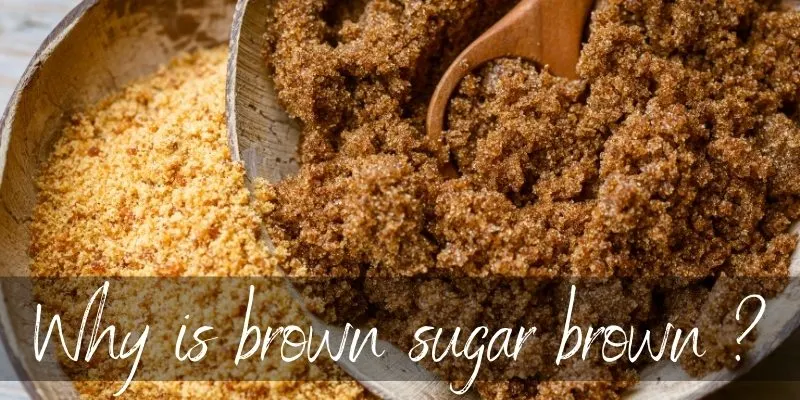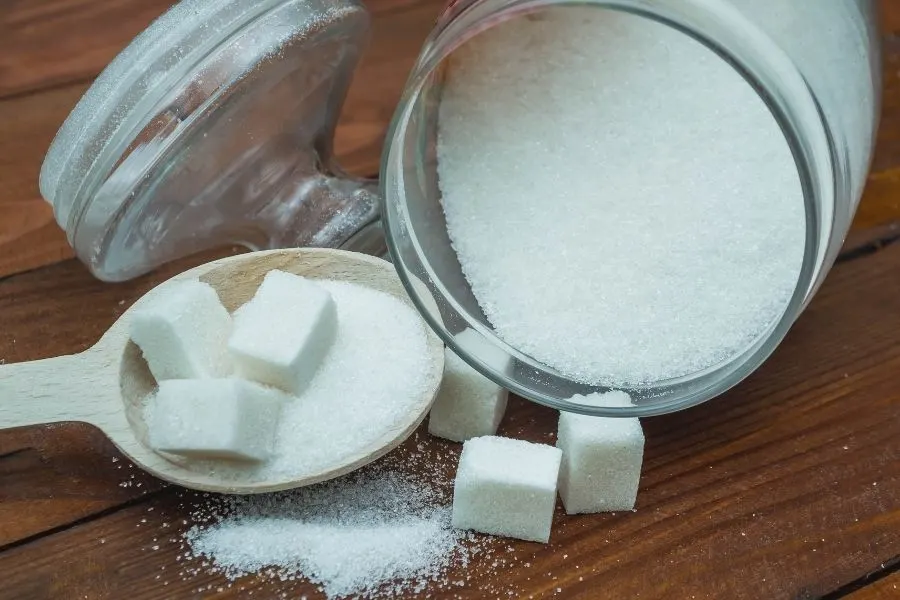Brown sugar is a common ingredient in recipes that call for an extra dose of flavor. It also blends into doughs and cakes a little better than white sugar, and offers a chewy texture.
There are different brown sugar versions on the market, but one thing that all have in common is their color. Why is brown sugar brown ? Does it have anything special ? What makes it different from white sugar ? And is brown sugar supposed to be moist ? If yes, what’s the deal with the dry ones ? Let’s find out.

Why is brown sugar brown ?
Brown sugar is brown because it retains a good portion of molasses in its composition. The more molasses the sugar has, the darker it is. White sugar has had all of its molasses removed, while brown sugar has anywhere between 3.5% and 10% of its total weight in molasses.
The molasses is what gives brown sugar its color but also its flavor. It’s caramel-y, slightly earthy, and it will tint whatever drink or food you’re making.
Brown sugar wasn’t always used, since it was considered less desirable than white sugar.
Why molasses is extracted from sugar
White sugar, the molasses-free sugar, was for centuries the sugar to have because it had absolutely no flavor and it would not change whatever you were baking or cooking. This meant that other flavors – like vanilla, cinnamon, chocolate, fruits, etc could show up better in a recipe.
To this day white sugar is still the sugar most people use. It does not change anything at all about a recipe except by adding sweetness. In some foods or sweets, like white cake or angel cake, the use of white sugar is mandatory to keep that white color in the cake.
Read also: Does Cinnamon Dissolve ?
Does brown sugar taste different from white sugar ?
Yes, brown sugar does taste different from white sugar because of its molasses content. This means brown sugar tastes a bit like caramel but it also has a slightly bitter, earthy flavor that doesn’t sit well with just anyone.
So in a way, you can say brown sugar tastes less sweet than white sugar. The darker the brown sugar, the more molasses and the stronger the flavor.
Which sugar you use depends on what you like. If you simply want to sweeten something you’re definitely going to use white sugar. But if you want to add a little bit of flavor, you’re likely using brown sugar.
Why is brown sugar moist ?
Brown sugar is moist because it contains anywhere between 3.5% and 10% molasses by weight. Molasses is a thick, dark brown nearly black syrup that is extracted from sugar cane, and it’s a byproduct of making white sugar.
Brown sugar is ‘incomplete’ white sugar, in that the molasses hasn’t been completely removed, thus it retains some flavor and moisture. The more molasses in the sugar, the more moisture there will be and the softer it will appear. Muscovado brown sugar, or of the darkest on the market, has a wet sand texture.
The dry versions of brown sugar are the ones that have either a very low amount of molasses, or are actually counterfeit. Fake brown sugar is simply shite sugar that has been ‘washed’ with ground coffee to get a brown stain on it. It is then sifted and the coffee grounds disappear, leaving behind the stained sugar.
The flavor is vaguely similar to brown sugar, in that it’s a little bit bitter and earthy, and the sugar itself is sweet.
White sugar is completely dry
White sugar, having no molasses left, will be completely dry. It will not clump unless exposed to moisture. This doesn’t mean it will not draw moisture. Sugar by nature attracts and absorbs moisture and water, which is why cakes get a sticky top, especially if you sprinkle on some sugar.

How to keep brown sugar soft and clump-free
If you want to keep your brown sugar soft, clump-free, and nicely moist you have to be careful with the way you store it. Much more than with regular white sugar.
This part applies especially well to very moist, dark brown sugar, but you can store light brown sugar in the same way.
Keep brown sugar in an airtight container
The first and most important step is keeping your sugar in an airtight container that won’t allow any moisture to escape or seep in. It will also keep other flavor or smells away form your sugar.
Do not expose the brown sugar to heat
When you’re keeping your brown sugar on the counter, make sure it’s not particularly close to the stove, especially if you cook often. The heat generated by the stove can and will make the sugar stick together in clumps. You don’t have to store this sugar in the fridge, but be sure to keep it away from any hot areas.
This also means keeping it away from direct sunlight. If you live in a hot, sunny are this is going to work the same way as a stove.
Always take sugar with a clean, dry spoon
When you handle brown sugar, always make sure your spoon, cup, or any other utensil is perfectly dry, and clean. Always make sure the spoon is dry and clean, and has nothing else on it, even if it means washing an extra spoon at the end of the day.
This way you’re not adding anything moist or wet into your already moist sugar. So this means no adding brown sugar with a coffee-soaked teaspoon, or adding brown sugar with a tablespoon coated in butter.
Brown sugar substitutes
If you find yourself in the position to need to substitute brown sugar, you have a few options. Some of them are readily available, and some of them can be circumvented.
For example if brown sugar is supposed to darker and tint a stew, you can simply use white sugar with some beef or mushroom stock. Both add a good amount of darkness to any sauce or stew or broth. In a pinch you can even use soy sauce.
White sugar and molasses
If all you’ve got is white sugar, then get a bottle of molasses (or treacle, it’s the same thing) and mix them. The more molasses, the darker the sugar but also the stronger the flavor.
Use a 1:15 molasses to white sugar ratio to get a light brown sugar. Keep in mind that molasses is very thick and sticky, so you have to mix them very well.
Maple sugar
Maple sugar is made from the same maple sap that maple syrup is made from. The more you simmer maple sap, it turns into maple syrup, them taffy, and eventually maple sugar. This is a long process and takes a lot of maple sap since it isn’t the sweetest sap out there.
But in the form of maple sugar, it offers a beautiful flavor, even better than brown sugar in a way. It’s not as easy to find as brown sugar, but if you live in Canada or the northern states of America, you can have an easier time finding this.
In short, brown sugar relies heavily on molasses for looks, texture, moisture, and overall flavor. Your best bet is to have a bottle of molasses at home and use that every time you want to make your sugar that much deeper in flavor.

